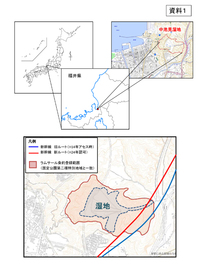Objections to the Construction Plan: Hokuriku Bullet Train Railroad Passing through Nakaikemi-shicchi. NACS-J submitted a petition to MOE and MLITT.
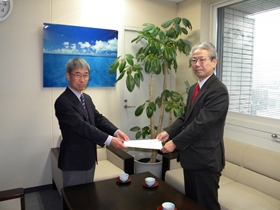
|

|
|
Left: Mr. Akira Kameyama, Chair of the Board of Directors (NACS-J)
Right: Mr. Kazuaki Hoshino, Deputy Director (Ministry of the Environment)
|
Submitted a petition to Mr. Amijima (Railway Facility Division, Ministry of Land, Infrastructure, Transport and Tourism)
|
November 19th 2012
Mr. Hiroyuki Nagahama
Minister of the Environment
Mr. Yuichiro Hada
Minister of Land, Infrastructure, Transport and Tourism
Dear Mr. Nagahama and Mr. Hada,
A Petition: Revision of the Construction Plan for Hokuriku Bullet Train Railroad which Passing through Nakaikemi-shicchi, Registered Wetland under Ramsar Convention.
Due to its significance and abundance in biological diversity, Nakaikemi-shicchi (Tsuruga city, Fukui prefecture) was successfully designated as international protected wetland under Ramsar Convention in July 2012. The preceding year 2011, the wetland was incorporated into Echizen-Kaga Kaigan Quasi-National Park as well.
It means that the site has been protected by law since then. However, it was revealed that railroad would pass through this protected area in the construction plan newly released in August; its previous version was approved in June. (Annex1) Carrying the latest plan in execution will give considerable adverse impacts on wetland conservation as follows:
1. Ramsar site is internationally pledged of enduring conservation-based management due to its academic and conservational values. The approved construction plan ruins trust in our country in international arena, and also it could be huge threat on the conservation policy in other Ramsar sites. It is truly critical matter.
2. Nakaikemi-schicchi is peculiar wetland with peat layers accumulated over a hundred thousand years long history. This wetland could be formed by the distinctive topographical characteristics called sac-like waste-filled valley, the wetland surrounded by mountain ranges. The approved construction plan indicates that the railroad will go through those mountains, and that will change peripheral hydro-system and ground water systems. Consequently it is inevitable to affect over the whole ecological system including its ecological functions. Furthermore past environmental impact assessment conducted by Japan Railway Construction, Transport and Technology Agency (JRTT) was insufficient its survey/evaluation methods indeed. More than worse, the railroad plan showed obvious change its route cutting inward much closer to core preservation area.
3. Ushirodani valley, locally called Oshatan, is under the construction plan and is known the area for 10 endangered species including mizutoranoo (Eusteralis yatabeanus) and other rare species distributing intensively. It is also significant habitat for Japanese firefly (Luciola lateralis) compared with any other places over the country. Namely Ushirodani is the very crucial hot spot in Nakaikemi-shicchi for conservation of biological diversity (Annex 2). The approved construction plan, as it stands now, will totally destroy Ushirodani area.
As reasons mentioned above, NACS-J hereby strongly request following two actions and its immediate implementation.
-It is unacceptable that bullet train railroad passing through the internationally pledged preservation area under Ramsar Convention. Japan has been given a duty to comply with Ramsar Convention as a contracting country. It means that present construction plan should be changed immediately.
-For a change the plan, we request that you ensure transparency in whole process, and assure scientifically reasonable survey/evaluation being done. All is for avoiding any negative impacts on natural environment in Nakaikemi-shicchi and its surroundings.
Sincerely yours,
←Click image to enlarge. The location: Nakaikemi-shicchi and planned railroad passing through the wetland.
Annex1 PDF The location: Nakaikemi-shicchi and Hokuriku bullet train planned route
Annex2:
A Summary Report: Biological Significance of Ushirodani Valley in Nakaikemi-shicchi, a Ramsar Convention Designated Wetland.
Prepared by NACS-J
Introduction
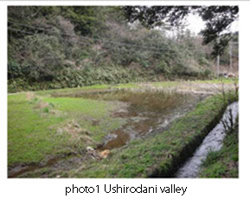
This is a summary of compiled biological information in Ushirodani valley (photo1), in which JRTT planned to construct railroad for Hokuriku bullet train.
-Local groups and field study specialists in this area provided us biological information. We appreciate their support to prepare this report in great part.
-However, the report itself had to be prepared in urgent situation to correspond against the newly approved construction plan. Therefore we think it is necessary to have robust structural survey being done for further sufficient evaluation of biological significance in this area.
-We do not indicate some common names of rare species in this paper due to conservation reason.
Environmental Significance
1. It is habitat for 10 threatened species and more species rarely occurred.
Our survey showed the fact that Ushirodani valley was habitat for more than 20 listed species (10 Threatened, 11 Near-Threatened) on the Red List published by Ministry of the Environment.
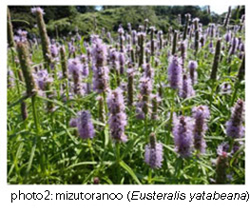
Planned railroad will go through marshy ground which is exactly the habitat for threatened aquatic species gathered. Diverse aquatic fauna and flora are observed there including threatened species such as mizutoranoo (Eusteralis yatabeana photo2), mizuoobako (Ottelia japonica), Morton damselfly (Mortonagrion selenion), kurogengoro (Cybister brevis), mizukohakugai (Gyraulus sortitai), Japanese rice fish (Oryzias latipes), yokohamashijiragai (Inversiunio jokohamensis), Asian clam(Corbicula leana) and natanekibasanagigai (Vertigo eogea eogea).
Yokohamashijiragai (Inversiunio jokohamensis) and Morton damselfly (Mortonagrion selenion) : There are diverse species which could be observed exclusively in Ushirodani within Nakaikemi-shicchi. It indicates that the environment is quite profound because of remaining rice paddy condition in Ushirodani despite the fact that had disappeared mostly in past 20 years. Especially Ushirodani is a significant biological hot spot in Nakaikemi-shicchi.
Besides marsh ground in valleys, forested area on both sides also supports threatened orchid species and provides reproductive habitat for rare butterfly species. Also birds breeding only in Japan such as Japanese yellow bunting (Emberiza sulphurata : Vulnerable, IUCN Red List) or Japanese night heron (Gorsachius goisagi : Endangered, IUCN Red List) are observed in Ushirodani. Some studies indicated that Japanese night heron and Grey-faced buzzard (Butastur indicus :Vulnerable, Red List MOE) might be breeding in Ushirodani valley.
2. Environmental significance in national wide view
Nakaikemi provides northern Japanese type-specimen of rice fish (Oryzias sakaizumii) which was newly found species in June. Ushirodani valley is biologically important area as corridor which connects between Nakaikemi-shicchi and its outer habitats.
Ushirodani valley is the site where Japanese firefly (Luciola lateralis) is most frequently observed among other spots in Nakaikemi-shicchi. Compared with the national survey results done by MOE (a project called Monitoring site 1000 satochi, done at 40 sites and more), firefly counts in Ushirodani was the highest among all the monitoring sites. It indicates that Ushirodani valley is one of environmentally crucial sites throughout the whole nation.
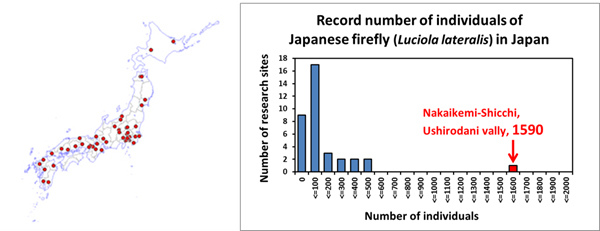
Figure: Firefly monitoring sites in Japan and its distribution (left) and a comparative study: the records of firefly individuals in Nakaikemi and other national monitoring sites (right). For comparison, we used average scores in 2 years (2010, 2011) for 36 monitoring sites. Nakaikemi also showed the highest firefly population value per research area among sites.
3. Abundant spring water resource supporting abundance in biota
Spring water runs constantly from the hillsides in Ushirodani valley, and this whole water system supports wetland environment formation stable. Mountains both sides supply water into the wetland. Unbroken stream lines coming from wetland create peripheral landscape, biotic community and hydrology system. Consequently all of this supports abundant biota at this moment. Especially the site right above the planned railroad route is exactly the spot with greater spring flow in Ushirodani valley.
Spring water from Ushirodani valley has been used for rice paddy field by human, moreover, a spring itself is a subject to worship in the community. Ushirodani provides a base for local activities and it is planned to be a main gate for visitors to this Ramsar site. Thus Ushirodani valley is important in various ways such as agricultural resource, cultural belief, environmental activities and recreational resource.
Information provided by:
NPO Wetland Nakaikemi: Mr. Susumu Sasaki, Mr. Ichiro Yoshida, Mr. Yuma Fujino, Mr. Tetsu Chijiiwa, Mr. Shigeki Wada
Yasuro Kakuno PhD. (Kobe University)
Norio Hirai PhD. (Osaka Prefecture University)



